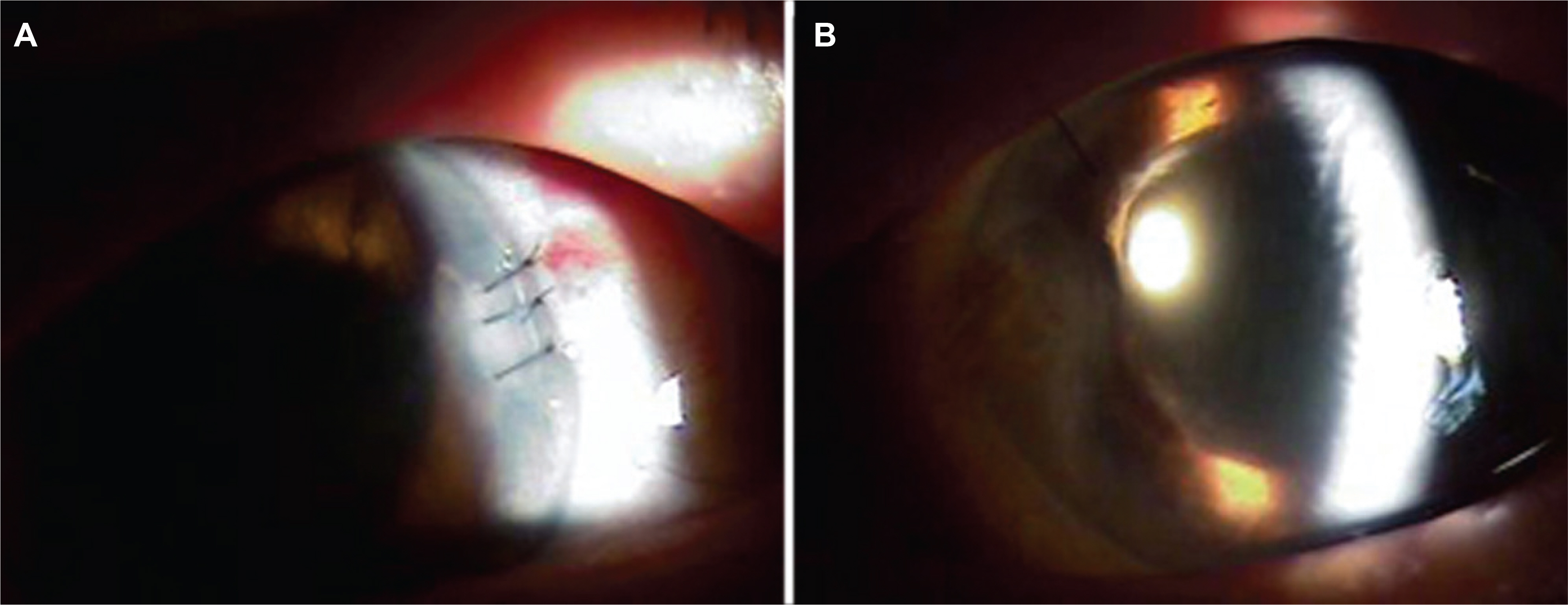J Korean Ophthalmol Soc.
2009 Feb;50(2):313-317. 10.3341/jkos.2009.50.2.313.
The Treatment of Epithelial Ingrowth After Phacoemlusification Through Clear Cornea Incision
- Affiliations
-
- 1Department of Ophthalmology, Chuncheon Sacred Heart Hospital, Hallym University, School of Medicine, Chuncheon, Korea. mcshin@hallym.ac.kr
- KMID: 2212070
- DOI: http://doi.org/10.3341/jkos.2009.50.2.313
Abstract
- PURPOSE
To report a case of epithelial ingrowth treatment by surgical excision of epithelial tissues and intracameral 5-fluorouracil injection.
CASE SUMMARY
A 70-year-old female patient who underwent phacoemulsification through clear cornea incision in both eyes 2 years before, was referred for her left ocular pain and corneal edema of 3 months' duration. Diffuse sheet-like epithelium grew from the clear cornea incision site to the pupil margin lesion of the iris. The epithelial tissues were excised and 5-fluorouracil was injected intracamerally. There were no recurrences for 2 months.
MeSH Terms
Figure
Reference
-
References
1. Vargas LG, Vroman DT, Solomon KD, et al. Epithelial Down-growth after Clear Corena Phacoemulsification: report of two cases and review of the literature. Ophthalmology. 2002; 109:2331–5.2. Sullivan GL. Epithelization of the anterior chamber following cataract extraction: a new approach to treatment. Trans Am Acd Ophthalmol. 1958; 56:606–54.3. Long JC, Tyner GS. Three cases of epithelial invasion of the anterior chamber treated surgically. Arch Ophthalmol. 1957; 58:396–400.
Article4. Brown SI. Treatment of advanced epithelial downgrowth. Trans Am Acd Ophthalmol. 1973; 77:618–22.5. Friedman AH. Radical anterior segment surgery for epithelial invasion of the anterior chamber: report of three cases. Trans Am Acd Ophthalmol. 1977; 83:216–23.6. Stark WJ, Michels RG, Maumenee AE, Cupples H. Surgical management of epithelial ingrowth. Am J Ophthalmol. 1978; 85:772–80.
Article7. Maumenee AE, Paton D, Morse PH, Butner R. Review of 40 histologically proven cases of epithelial downgrowth following cataract extraction and suggested surgical management. Am J Ophthalmol. 1970; 69:598–603.
Article8. Knauf HP, Rowsey JJ, Margo CE. Cystic epithelial down-growth clear-corneal cataract extraction. Arch Ophthalmol. 1997; 22:330–5.9. Chen SH, Pineda R 2nd. Epithelial and fibrous downgrowth: mechanism of disease. Ophthalmol Clin North Am. 2008; 15:41–8.10. Jadav DS, Rhlander NR, Vold SD, et al. Endoscopic photo-coagulation in the management of epithelial downgrowth. Cornea. 2008; 27:601–4.
Article11. Weiner MJ, Trentacoste J, Pon DM, Albert DM. Epithelial downgrowth: a 30-year clinicopathological review. Br J Ophthalmol. 1989; 73:6–11.
Article12. Kim SK, Ibarra MS, Syed NA, et al. Development of epithelilal downgrowth several decades after intraocular surgery. Cornea. 2005; 24:108–9.13. Cho JS, Ko MK, Shin JC. Epithelial ingrowth of anterior chamber and anterior surface of vitreous. Korean J Ophthalmol. 1998; 12:118–21.
Article14. Lai MM, Haller JA. Resolution of epithelial ingrowth in a patient treated with 5-fluorouracil. Am J Ophthalmol. 2002; 133:562–4.
Article15. Tomlins PJ, Savant V, Quinlan M. Failure of intracameral fluorouracil to resolve an epithelial ingrowth following clear corneal cataract surgery. J Cataract Refract Surg. 2007; 33:923–4.
Article16. Lee BL, Gaton DD, Weinreb RN. Epithelial downgrowth following phacoemulsification through a clear cornea. Arch Ophthalmol. 1999; 117:283.
Article17. Shikh AA, Damji KF, Mintsioulis G, et al. Bilateral epithelial downgrowth managed in one eye with intraocular 5-fluor-ouracil. Arch Ophthalmol. 2008; 120:1396–8.18. Srinivasan S, Jones DH, Jay JL, Roberts F. Epithelial down-growth following clear cornea phacoemulsification in a buphthalmic eye. Br J Ophthalmol. 2004; 88:152–3.
Article19. Kim SW, Byun YJ, Kim EK, Kim TI. Treatment of epithelial ingrowth after laser in situ keratomilusis using amniotic membrane patch. J Korean Ophthalmol Soc. 2007; 48:230–7.20. Lim TH, Kim MJ, Kim TI, Tchah HW. Lamellar keratoplasty and restoration of traumatic dislocation of LASIK flap using human fibrin adhesive. J Korean Ophthalmol Soc. 2005; 46:1741–6.21. Hunyor AP, Davis Belcher III. BSC. Epithelial and Fibrous Invasion of the Eye. Steinert RF, Fine IH, Gimbel HV, editors. Cataract Surgery: Technique, Complications, Management. 2nd ed.Philadelphia: Saunders;2004. chap. 46.
- Full Text Links
- Actions
-
Cited
- CITED
-
- Close
- Share
- Similar articles
-
- Management of Detached Lenticule in Case of Extensive Epithelial Ingrowth Following Automated Lamellar Keratoplasty
- Treatment of Epithelial Ingrowth after Laser in Situ Keratomilusis Using Amniotic Membrane Patch
- Epithelial ingrowth of anterior chamber and anterior surface of vitreous
- The Analysis of Epithelial Ingrowth after LASIK Using a Femtosecond Laser
- A simple method for the removal of epithelium grown beneath the hinge after LASIK





